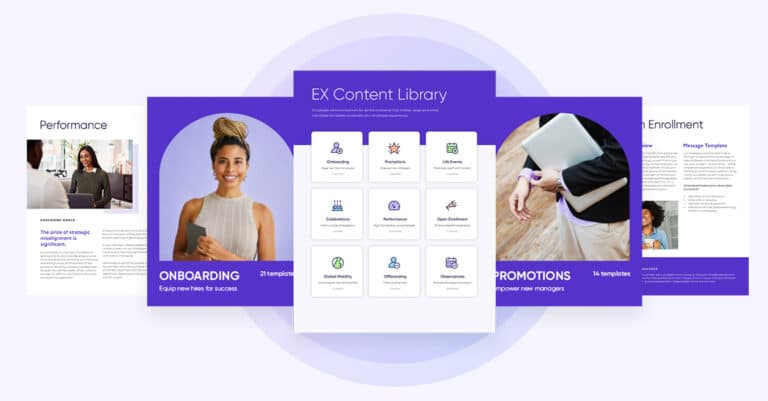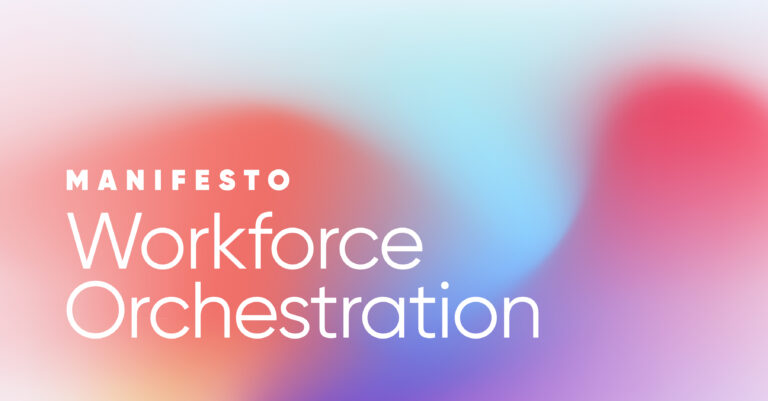The savviest players in the business world are data-driven organizations. Instead of relying on guesswork, their executives use a diverse array of data to make smart decisions. It helps them predict future opportunities and sidestep obstacles.
These companies continuously fine-tune their strategies and processes based on data to make their operations smoother, keep customers happy, and outshine the competition.
The same goes for HR and internal communications leaders. Quality employee data is the key to elevating employee engagement, developing your workforce, and retaining high performers—components of the employee experience that sustain a company’s success.
Businesses with a positive employee experience are 1.3 times more likely to outperform their competitors.
McKinsey & Company
HR leaders need quantifiable employee data to communicate effectively, reduce turnover and absenteeism, encourage higher adoption of their initiatives, refine programs that maximize productivity, and create a feedback loop on employee satisfaction.
How accurate and robust is the employee data at your company? Turbocharging data doesn’t mean simply gathering more information but harnessing its potential to create a thriving workplace. The effort starts with a streamlined process to capture data, ensure accuracy and integrity, and implement automation for predictive analytics to strengthen employee engagement and retention.
Here are three key strategies to help you turn your employee data into a strategic asset.
1. Integrate your tech stack for seamless data flow
One of the primary challenges organizations face is the siloed nature of their data. Employee information often resides in disparate systems, making it difficult to gain a comprehensive view.
Human capital management (HCM) platforms have traditionally been the primary system of record, sometimes linked to various disconnected systems. According to HR analyst Josh Bersin, the typical HR organization has 11 systems of record, the typical recruiting department has more than 10, and the typical L&D department has almost 20. Add to the mix software for payroll and attendance, internal communications, recognition programs, and wellness platforms.
HR leaders should integrate systems so data and information can flow seamlessly across various departments. There has been a more recent shift toward AI-powered intelligent communication systems like Firstup that integrate data from various HR systems and applications that employees use in their daily work lives.
These platforms focus on the employee first and excel at personalized communications, automated employee journeys, mobile access, and data and insights—providing a modern approach to help employees easily find and access a wide range of information.
Intelligent communication platforms have become the hub of HR’s employee experience initiatives. They provide essential tools to connect, reach, and engage employees with hyper-personalized communications, no matter where or when they’re on the job. They’re also the source of truth for advanced analytics that provide insights into employee trends and behaviors.
“As the market grows, EX platforms are becoming systems of records themselves. Firstup, for example, uses AI to understand each employee’s pattern of communication so it can send messages in the form (email, push notification, etc.) and time of day that works best for each employee.”
Josh Bersin, The Josh Bersin Company, HR Predictions for 2024: Imperatives for the Year Ahead
2. Prioritize data accuracy and integrity
Your employee data is only useful if it’s clean, accurate, and comprehensive. A comprehensive approach to data cleanliness allows businesses to proactively identify and address inconsistencies, redundancies, and errors.
Higher quality data helps you streamline HR processes, improve communication, and identify ways to improve the employee experience. By ensuring that employee data is up to date—including their region, roles, demographics, and other details—you can personalize communication at every stage of the employee journey.
Strategic data management requires annual audits. Involve stakeholders from across the organization to help spot any gaps or areas where employee data should be updated or put to better use. This includes looking for missing data that could enhance employee experiences, facilitate critical communications, and provide better access to resources.
Data audits should also ensure you’re compliant with relevant laws such as GDPR, HIPAA, and other regional regulations to uphold data security and privacy standards.
Hyper-personalized comms for every employee
3. Implement AI to facilitate predictive analytics
You’ve streamlined your systems and cleaned up your data—now it’s time to put it to good use. When you combine data from your HR systems with engagement data from an AI-powered intelligent communication platform like Firstup, you’ll find yourself in a technological watchtower.
From this vantage point, you have a clear view of employee engagement across the company, as well as different departments, teams, and individuals. Firstup has found a clear positive correlation between how much employees interact with communications—in the form of views, likes, comments, and shares—and how enthusiastic they are about their work.
These analytics reveal that power users of your communications platform are likely to be some of your highest performers. The inverse is also true: Less engaged employees are more likely to be at risk of attrition. Such insights serve as early warning signals of potential resignations up to three months in advance, which gives HR and managers an opportunity to turn the trend around.
The healthcare industry has faced ongoing challenges with recruitment and retention, which makes employee engagement a critical endeavor. Boston Children’s Hospital credits the metrics package in their Firstup platform for giving them visibility into engagement among their 16,000 employees. Stephen Coldwell, Director of Internal and Executive Communications, relies on storytelling to unite and inspire their frontline employees.
“We’re learning more than we have ever had access to before,” he said. “Being able to actually see who is engaging with what content—who are our most engaged employees—is big. If we have an idea of what really appeals to people, we can decide where to focus our efforts.”
Combined with past trends, predictive analytics can forecast employee turnover at light speed compared to traditional HR measures of employee sentiment. Once you’ve identified disengaged workers, you can use other AI features within Firstup to craft personalized campaigns to engage employees and improve retention.
AI can automate other routine tasks, freeing up valuable time for HR teams to focus on strategic initiatives and more high-touch aspects of their roles. AI has been shown to make people 12% more productive and capable of completing work 25% faster, while increasing the quality of their work by 40%. From recruitment to employee development, AI enhances efficiency and turns your workforce data into a dynamic resource for strategic planning.
Employee engagement starts with data
Today’s workers crave a more modern experience, similar to the personalization they enjoy as consumers. Robust data is a must-have for HR teams dedicated to meeting employees’ needs and preferences. Without clear insights into performance and engagement, efforts to improve the employee experience might end up wasting time and missing opportunities.
No matter the size of their HR departments, Firstup customers have cultivated a stronger data-driven culture by implementing intelligent communication technology and analytical processes that turn employee data into a strategic asset.
Organizations that embrace this approach are better positioned to motivate employees, spark innovation, and nurture a thriving work environment.
Activate Your HRIS Data to Deliver More Personalized Employee Experiences
Learn how you can integrate employee data for meaningful communication
Download PDF









